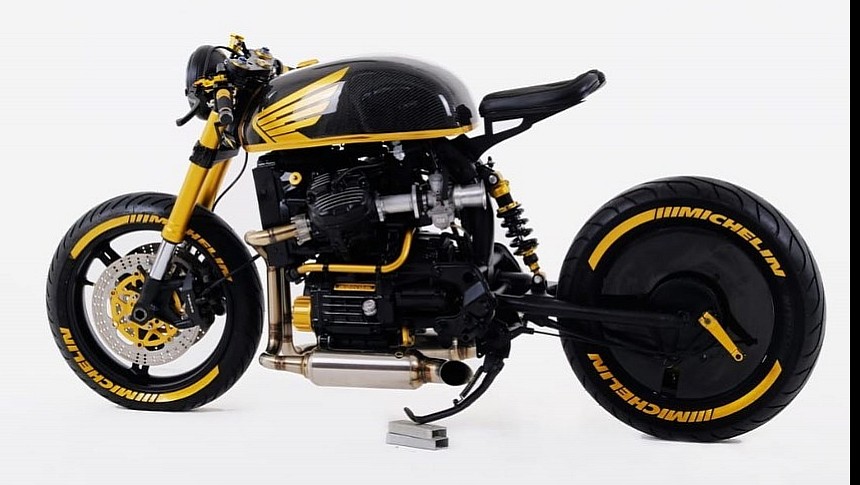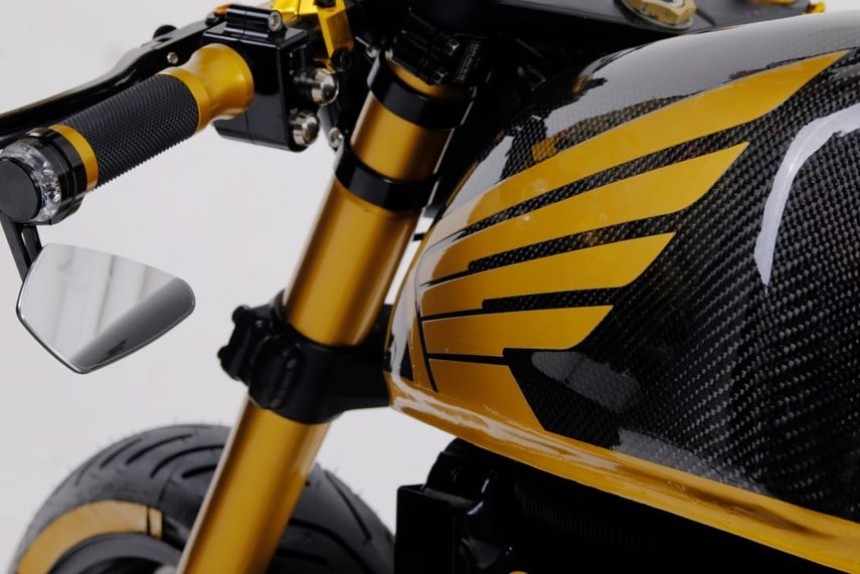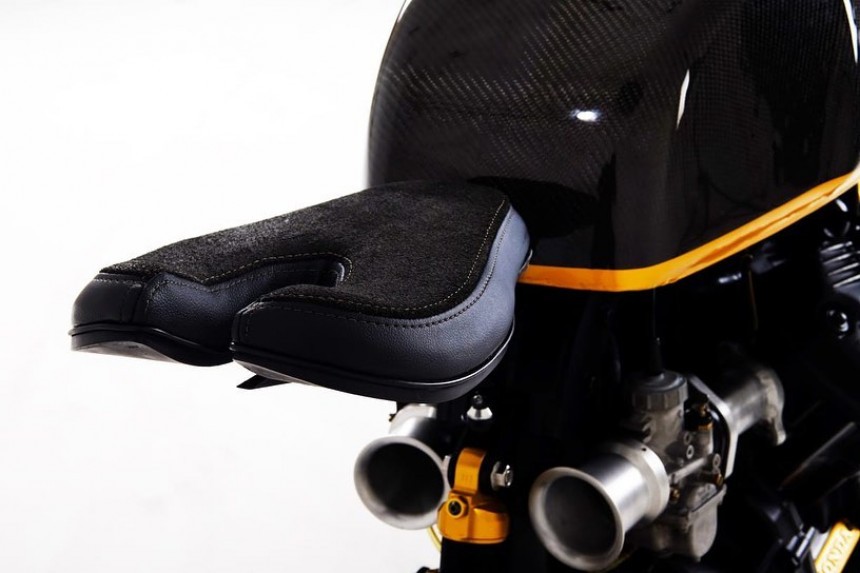Over the years, we’ve looked at custom motorcycles from all across the globe here on autoevolution, but this might be the first time we feature a machine built in the Dominican Republic. The said project was put together by one Francis Gomez, who operates as Charlie’s Atelier in the bustling capital of Santo Domingo. As you can probably tell, Francis is the sort of guy who likes to dial things up to eleven.
The starting point of his build came as a stock Honda CX500, which was to become an aggressive cafe racer with colors influenced by John Player Special F1 liveries of yore. Well, that was the main source of inspiration according to senhor Gomez, but we reckon this thing would serve as a great two-wheeled effigy of the Wu-Tang Clan, too. It looks absolutely superb, either way, and there’s a lot more to it than just a snazzy color scheme.
As for the donor, the CX500 is quite a popular platform for customization thanks to its reliability and versatile nature. Released by Honda in 1978, it came with a liquid-cooled 497cc V-twin powerhouse mounted longitudinally inside the frame. With 10:1 compression and four valves per cylinder, the engine is capable of spawning up to 50 hp at 9,000 rpm.
Power travels to the rear wheel by means of a five-speed gearbox and a driveshaft, giving the CX500 a top speed of 112 mph (180 kph). Those are pretty respectable digits, but Charlie’s Atelier wanted to improve upon the motorcycle’s traits in just about every way, from the mechanical aspect to cosmetics and everything in between.
We’re not told whether this was a customer commission or a personal project, but what’s crystal-clear is that Francis left no stone unturned. As a matter of fact, there’s very little stock componentry left on his CX500 cafe racer at all, so let’s dive in for a closer look at the modifications that took place here. You ought to buckle up, because it’s going to be a wild ride!
While dismantling the classic V-twin Honda, Sir Gomez sent all the OEM bodywork and suspension to the parts bin. Things like the subframe, front wheel, and cockpit equipment followed suit, leaving him with a blank canvas ripe for customization. Then, a Suzuki GSX-R came into the picture, donating all its front-end hardware for the Dominican artisan to use on the CX.
The Gixxer’s inverted forks, Tokico brake calipers, and floating rotors have been seamlessly transplanted onto their new host, and so was its three-spoke front wheel. Custom triple clamps link the fully-adjustable GSX-R forks to the Honda chassis, with a premium LED headlight sitting a bit further ahead. It’s secured in place via bespoke brackets, attaching to the uppermost portion of the fork tubes.
In the cockpit, you will now find a myriad of aftermarket goodies replacing the stock parts. Clip-on handlebars push the bike’s ergonomics well into cafe racer territory, sporting CNC Racing control levers and snazzy Rizoma grips. Additionally, a pair of bar-end turn signals and underslung mirrors also make an appearance, all hailing from Motogadget’s catalog.
Behind the upgraded cockpit area lies the only piece of bodywork worn by this specimen – a carbon fiber fuel tank whose design is based on the original part. Further back, one may see a handmade bobber-style subframe that’s been fabricated in-house, supporting a tiny solo seat upholstered in standard black leather on the sides and suede up top.
The rear-end suspension work is even more intriguing, though, because Francis converted the CX500 from its initial twin-shock arrangement to a sportier monoshock setup. It employs high-grade YSS componentry, offering a colossal improvement over the factory rear suspension. To beef up the southernmost section of this custom head-turner, he made a couple of rear wheel covers from scratch, once again using carbon fiber as his material of choice.
Aiming for both ample grip and bolt looks, Charlie’s Atelier wrapped the creature’s hoops in Michelin Pilot Power 3 tires with yellow brand logos adorning their sidewalls. The electronics got hooked up to a compact lithium-ion battery from Antigravity’s catalog, which is most likely hidden underneath the fuel tank.
Francis didn’t mention its exact location, so we’re simply giving you our best guess. He went to town when it came to the powertrain, as well, replacing the original Keihin carbs with fresh Mikuni VM34 items. They breathe through tailor-made velocity stacks, but the V-twin mill also benefits from a new stainless-steel exhaust system.
Moreover, an aftermarket radiator was installed to keep temperatures in check. The last thing we need to talk about is the color scheme worn by this showstopper – a tasteful blend of black and gold with exposed carbon fiber on the gas tank. It’s nothing we haven’t seen before, but the execution is quite simply mesmerizing to say the least!
As for the donor, the CX500 is quite a popular platform for customization thanks to its reliability and versatile nature. Released by Honda in 1978, it came with a liquid-cooled 497cc V-twin powerhouse mounted longitudinally inside the frame. With 10:1 compression and four valves per cylinder, the engine is capable of spawning up to 50 hp at 9,000 rpm.
Power travels to the rear wheel by means of a five-speed gearbox and a driveshaft, giving the CX500 a top speed of 112 mph (180 kph). Those are pretty respectable digits, but Charlie’s Atelier wanted to improve upon the motorcycle’s traits in just about every way, from the mechanical aspect to cosmetics and everything in between.
We’re not told whether this was a customer commission or a personal project, but what’s crystal-clear is that Francis left no stone unturned. As a matter of fact, there’s very little stock componentry left on his CX500 cafe racer at all, so let’s dive in for a closer look at the modifications that took place here. You ought to buckle up, because it’s going to be a wild ride!
The Gixxer’s inverted forks, Tokico brake calipers, and floating rotors have been seamlessly transplanted onto their new host, and so was its three-spoke front wheel. Custom triple clamps link the fully-adjustable GSX-R forks to the Honda chassis, with a premium LED headlight sitting a bit further ahead. It’s secured in place via bespoke brackets, attaching to the uppermost portion of the fork tubes.
In the cockpit, you will now find a myriad of aftermarket goodies replacing the stock parts. Clip-on handlebars push the bike’s ergonomics well into cafe racer territory, sporting CNC Racing control levers and snazzy Rizoma grips. Additionally, a pair of bar-end turn signals and underslung mirrors also make an appearance, all hailing from Motogadget’s catalog.
Behind the upgraded cockpit area lies the only piece of bodywork worn by this specimen – a carbon fiber fuel tank whose design is based on the original part. Further back, one may see a handmade bobber-style subframe that’s been fabricated in-house, supporting a tiny solo seat upholstered in standard black leather on the sides and suede up top.
Aiming for both ample grip and bolt looks, Charlie’s Atelier wrapped the creature’s hoops in Michelin Pilot Power 3 tires with yellow brand logos adorning their sidewalls. The electronics got hooked up to a compact lithium-ion battery from Antigravity’s catalog, which is most likely hidden underneath the fuel tank.
Francis didn’t mention its exact location, so we’re simply giving you our best guess. He went to town when it came to the powertrain, as well, replacing the original Keihin carbs with fresh Mikuni VM34 items. They breathe through tailor-made velocity stacks, but the V-twin mill also benefits from a new stainless-steel exhaust system.
Moreover, an aftermarket radiator was installed to keep temperatures in check. The last thing we need to talk about is the color scheme worn by this showstopper – a tasteful blend of black and gold with exposed carbon fiber on the gas tank. It’s nothing we haven’t seen before, but the execution is quite simply mesmerizing to say the least!










